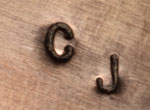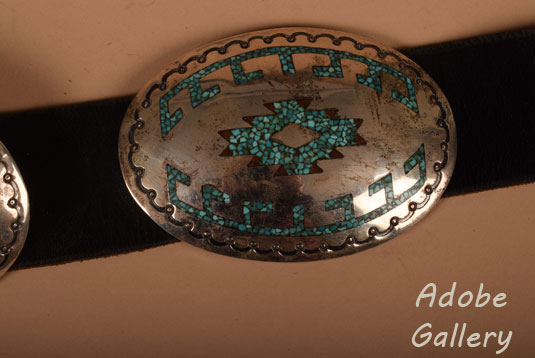Navajo Silver Concho Belt with Red Coral and Turquoise Chip Inlay [SOLD]
+ Add to my watchlist Forward to Friend
- Category: Belts and Buckles
- Origin: Diné of the Navajo Nation
- Medium: Silver, coral, turquoise, leather belt
- Size: 44” belt;
conchas 2-¾” tall x 3-⅞” wide
Weight: 1 pound 8.4 ounces - Item # C4569T SOLD
This ten-concho belt was fashioned in a way that is understated and allows the wearer to possess a functional work of art. The shape, weight, and flush ornamentation make it easy to wear. It is not too heavy, and the designs are striking, yet simple. The Diné of the Navajo Nation artist is Corbet Joe.
Each concho was hand-crafted and silver shell-like ovals were affixed with copper pieces on the back that allow them to be worn over any belt that is approximately 1-⅝” wide or narrower. The edges were stamped with small arches that are attached to one another with tiny, stamped circles, giving the border a curving, cork-screw-like pattern.
On both the top and bottom, channels in a barbed geometric pattern were carved and inlaid with very refined pieces of turquoise in a range of azure and verdant colors. Each concho’s center features a geometric, all-seeing, eye pattern, with the center being left silver. The areas close to the silver center were inlaid with turquoise and faded to small triangles of inlaid red coral chips, turning the tips of this portion from cool to warm. Both the barbed framing and central chip inlaid patterns are reminiscent of those used in Navajo textiles.
 Corbet Joe is another mysterious jeweler yet unfamiliar to Adobe Gallery, and we are pleased to experience some of his work. From what can be gleaned, Corbet Joe is a Diné artist who tends to focus on creating turquoise and red coral chip inlay silver jewelry. Chip inlay work is an exponentially tedious process that involves placing very small pieces of crushed gemstones into channeled inlays, piece by piece, and finishing it with epoxy resin. It requires incredible amounts of patience and willpower and can result in stunning finished pieces of jewelry. Corbet Joe signs his work, C J with the letters typically offset.
Corbet Joe is another mysterious jeweler yet unfamiliar to Adobe Gallery, and we are pleased to experience some of his work. From what can be gleaned, Corbet Joe is a Diné artist who tends to focus on creating turquoise and red coral chip inlay silver jewelry. Chip inlay work is an exponentially tedious process that involves placing very small pieces of crushed gemstones into channeled inlays, piece by piece, and finishing it with epoxy resin. It requires incredible amounts of patience and willpower and can result in stunning finished pieces of jewelry. Corbet Joe signs his work, C J with the letters typically offset.
The inventor of chip inlay was Tommy Singer (1940-2014), a silversmith who was a member of the Navajo Nation from Winslow Arizona. Singer grew up on the Navajo reservation and was taught his craft by his father beginning at the age of seven. Over time, he honed his craft working from a small studio surrounded by friends and family. Singer is credited with inventing the “chip-inlay” technique in the 1960s alongside his brothers William, Charlie, and Jackie. They used inlaid turquoise and coral pieces in silver laid out in traditional Navajo designs.
When asked about his work, Singer said, "Every piece is made with the various meanings from my traditional ways—the Navajo way of living. My father was a silversmith, too. He taught me and wanted me to continue this trade. It was my father's dream that I learn to silversmith so that I could continue his beliefs (Gregory Schaaf, 2003, page 292)."
Condition: Natural patina and silver pigmentation have occurred over time and this concho belt is in very good condition.
Provenance: This Navajo Silver Concho Belt with Red Coral and Turquoise Chip Inlay is from an estate in eastern Washington.
Resources: American Indian Jewelry I by Gregory Schaaf page 292
Recommended Reading: Evolving Southwest Indian Jewelry by Nancy N. Schiffer (Author)
TAGS: Navajo Nation, Southwest Indian Jewelry, Corbet Joe, Tommy Singer, Charlie Singer

- Category: Belts and Buckles
- Origin: Diné of the Navajo Nation
- Medium: Silver, coral, turquoise, leather belt
- Size: 44” belt;
conchas 2-¾” tall x 3-⅞” wide
Weight: 1 pound 8.4 ounces - Item # C4569T SOLD
Adobe Gallery Recommended Reading
Adobe Gallery Recommended Items
If you are interested in this item, we would also like to recommend these other related items:



